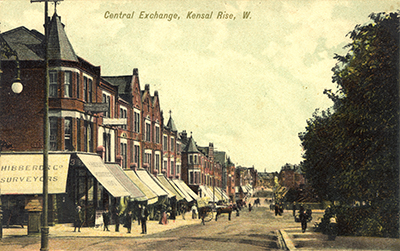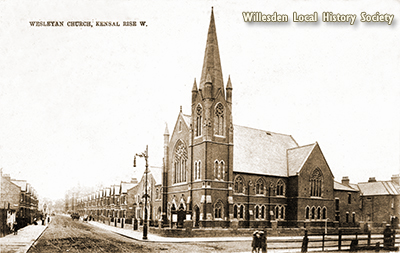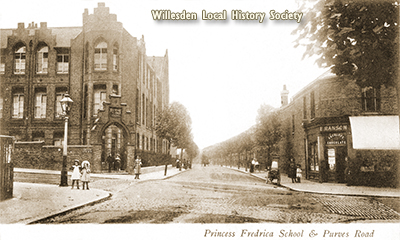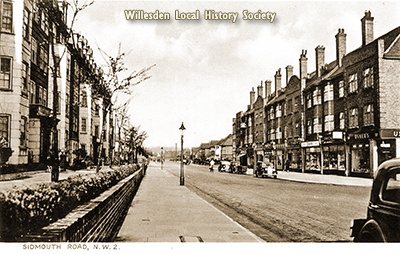
Kensal Rise

The History of Kensal Rise
Kensal Rise lies to the north of Kensal Green, going towards Willesden Green.
The “Village Green” of Kensal Green was a strip of common land alongside the Harrow Road, running west from Kilburn Lane, up to where Wakeman Road begins today. The small settlement around the green was surrounded by farm land and market gardens, providing meat, milk, vegetables and fruit for the City of London, a few hours walk away. Hay for the horses of London was also an important crop. The name “Kensal” had its origins in “Kingisholt”, the 12th Century name of the area of land immediately to the east of Kilburn Lane.
The beginning of the 19th century brought industry and job opportunities to Kensal Green, including the building of the Paddington arm of the Grand Junction Canal (1801), All Souls’ Cemetery (1833) and the London to Birmingham Railway (1837) and the Hampstead Junction Railway (1860).
St. John’s Church on the corner of Kilburn Lane and Harrow Road has been the spiritual centre for Kensal Green since 1844, originally built to serve the population of Kensal New Town. St. John’s National Schools building can be seen at the far side of the Church grounds, while ahead is the tall Old Vicarage, close to the boundary wall. The school was built in 1850, years before The First Education Act was passed , (in 1870.) Thousands of poor children in London had no education at all, but the young people of Kensal Green were more fortunate. Look for the name on the gable end of the school building. The Old Vicarage and the School are now occupied by Bales College, a Private school for senior pupils.
Kilburn Lane, following the modern boundary between Willesden, (Borough of Brent,) and Paddington, (Borough of Westminster.) Kilburn Lane is an ancient way across fields to Kilburn Priory, near the Edgeware Road. Kilburn Lane turns eastwards, about a quarter of a mile from the Church.
The Old Plough/Paradise By Way Of Kensal Green is a historic pub, which has been on the corner of Regent Street and Kilburn Lane since 1750. It was rebuilt in 1892, as more people were flooding into the area. The new name is recent, and is a reference to the proximity of Kensal Green Cemetery, and the last lines of a poem by G.K. Chesterton, The Rolling English Road.
– For there is good news yet to hear, and fine things to be seen,
Before we go to Paradise by way of Kensal Green.
The Queen’s Park Estate, of about 2,000 houses, lies to the east of Kilburn Lane, behind the Church grounds, and north of the Harrow Road. A frenzy of building from 1874 to 1886, produced terraces of handsome small houses, blotting out the fields of Kingisholt, north of Harrow Road. The Estate was the work of the Artizans, Labourers and General Dwellings Company, which aimed to provide decent houses for artizans, tradesmen, clerks, etc.
Chamberlayne Road is a busy thoroughfare and shopping centre, a late addition to the map of Kensal Green. There was no road north until 1893, only footpaths across the fields of Chamberlain’s Wood, (land owned by St.Paul’s Cathedral) up to Willesden Green. Local farms, with farmhouses facing onto Kilburn Lane, had been cut off from their fields by the London to Birmingham Railway in 1837. Chamberlain’s Wood Farm, also called Banister’s Farm, after the tenant farmer, was the nearest to Kensal Green. St. Pauls Commissioners were making plans to use the whole slope of Chamberlain’s Wood for building, and farmers were persuaded to surrender their farming leases. Banisters’ was released for building in 1888. All Souls’ College also joined in, buying five and a half acres from St.Pauls, for the purpose of building a road from Kensal Green to Willesden Green. This was started in 1893, and reached as far north as the Railway Station on the Hampstead Junction Railway, by 1895. Chamberlayne Road was born.
Landmarks of Chamberlayne Road include the Baptist Tabernacle, built in 1894, Kensal Rise School, now Ark Franklin Academy (1896), Kensal Rise Station (1873/1890) (Hampstead Junction Railway, now Overground, Stratford to Richmond.) Before Chamberlayne Road was built, a station appeared beside the railway, in 1873. It had been moved from Wrottesley Road when Willesden Junction Station opened its high level platform. The new Chamberlayne Road had to be taken over the tracks on a large embankment, with a Station Entrance at the top of the hill, and another at rail level in Station Road around the corner. The name Kensal Rise Station was given in 1890. Station Road has been a bus terminus since the days of horse-buses to London Bridge. The first motor buses began in 1911, and now the “Exchange” has buses serving many destinations .
Princess Frederica’s School, a C.of E. Primary School on Purves Road was opened in 1888. It was built by an enterprising group of Anglican nuns of the Church Extension Association, led by Mother Emily Ayckbowm. She was instrumental in raising funds to build not only Princess Frederica’s, but also John Keble School, Harlesden, Wilberforce and Gordon Schools in Kilburn, Saltram Crescent School in Paddington, and Liddon School in Kentish Town. The school is named after a young German cousin of Queen Victoria, who was supported by the Queen, when she was thrown out by her family for marrying a commoner. Princess Frederica was given a home at Hampton Court, and came into contact with the Kilburn Sisters, on taking an interest in the plight of poor families. Frederica donated funds, became a Patron of the School, and agreed to perform the Opening Ceremony in 1888.
Kensal Rise Library is opposite the school, on the corner of Bathurst Gardens. It was built as a Reading Room in 1900, on land leased by All Souls’ College. It was officially opened by the famous American Author, Samuel Clemens, a.k.a. Mark Twain, who was staying at Dollis Hill House . A Lending Library was added in 1904. Kensal Rise was one of the public Libraries closed by Brent Council in 2012, despite pleas from the Friends group to be allowed to run it on a voluntary basis.
Kensal Rise Methodist Church / Church of the Transfiguration. The Church with spire across the road, on the corner of Wrentham Avenue, was built by the Methodists in 1899. The main building was bought and converted into the Catholic Church of the Transfiguration, in 1977. The Methodist congregation kept the smaller Sunday School building on the left. The change in ownership reflects the influx of Irish Catholic families into the area during the 1960s to 1980s.
Chamberlayne Wood School/Manor School, at the corner of Okehampton Road, was built in 1902 for the Willesden School Board.
Kensal Rise Conservative Club opened on the corner of Hardinge Road in 1927, after the last streets of Kensal Rise had been completed. The main meeting room in the Club was named Pinkham Hall, in honour of the builder Charles Pinkham, who continued working until the streets of Kensal Rise were finished. The building now houses an independent Lexi Cinema.
Margaret Pratt
This is based on the online talk by Margaret Pratt and Harry Brown given to the WLHS in January 2021. The recording of the talk is available in the Archive section of the website, and detailed information is included in Journal 53, also available to members and in the Archive section of the website.



